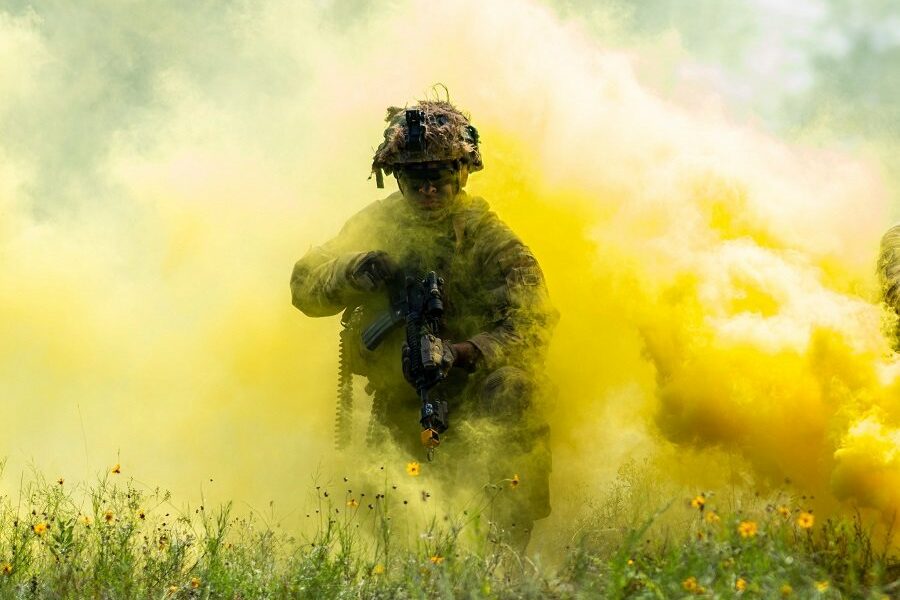Wars and Rumors of Wars
A detailed examination of conflicts around the globe and the threat they pose to Americans.

“Wars will continue to flare up between sinful human beings as long as they live in this fallen world, in which Satan is at work…. Christ himself declared there would continue to be ‘wars and rumors of war’ [Matthew 24:6]…. Only when he returns in glory to bring this world to its end and fully subjugate Satan will war cease.”
So says The Lutheran Study Bible, “Divine Warfare,” p. 376. That doesn’t mean we have to like it. We just have to acknowledge that we’re stuck with warfare, hoping and praying to keep it to manageable levels.
But that’s a tall order at the moment, considering that nine countries now hold a total of 12,000 nuclear weapons.
The Current Top 10 Most Deadly Conflicts
Granted, Russia and the U.S. hold more than 90 percent of those 12,000 weapons. But as tensions escalate around the globe, that’s hardly reassuring.
Here are the most violent conflicts currently being waged around the planet, with their minimum estimated fatalities over the last two years:
- Russia vs. Ukraine: 98,000
- Israel vs. Hamas: 43,000
- West African insurgencies/terrorism: 24,000
- Sudan civil war: 14,000
- Myanmar conflict: 13,000
- Mexican drug cartel violence: 11,000
- Boko Haram insurgency (Nigeria/Niger/Chad): 9,000
- Somali civil war: 8,000
- Ethiopia civil conflict: 8,000
- Democratic Republic of Congo (DRC) counterinsurgency/conflict with Rwanda, 7,500.
Let’s look briefly at each of these 10 conflicts with their causes, relevance to Americans, and prospects for peace or escalation.
- Russia vs. Ukraine: This is the world’s major conflict right now, and has been since Moscow invaded its former Soviet province in 2022, citing oppression of ethnic Russians and NATO’s overtures to Kyiv. To date, the Biden administration, with Republican support, has sent well over $175 billion in military and humanitarian aid to Ukraine. All Ukrainian territory from the Crimean peninsula to the northeast bordering Russia is now in the latter’s hands, while the latest Ukrainian counterattack into Russian territory is actually a rather small salient. However, the overall situation is hard to analyze because most major news outlets have abandoned objective reporting for pro-Zelensky cheerleading. We are heavily invested in this fight, at least indirectly — although lame-duck President Joe Biden has repeatedly said American boots will not be put on the ground there. Peace anytime soon is unlikely, as the Ukrainians are the victims and the Russians feel betrayed by the West. In the long term, Ukraine has little hope of defeating the much larger, more powerful Russian military. (And Kyiv is wearing out its welcome in Berlin, at least, as it turns out it was the Ukrainians, not the Russians, who blew up the Nordstream pipeline.) This is a war between two Orthodox Christian nations. The situation is byzantine, but the Ukrainian government is now persecuting the Orthodox churches affiliated with Moscow, to which about 20% of the population belongs.
- Israel vs. Hamas: The latest round of this millennia-old conflict kicked off last October when the jihadist group broke an agreement and massacred more 800 Israeli civilians, in addition to military members. Israel’s understandably massive response, including its invasion of Gaza, has claimed the lives of more than 40,000 Palestinians, if the latter’s counts are accurate (always questionable when they come from a terrorist organization). Of course, Hamas is really only Iran’s proxy in Tehran’s apocalyptic attempt to erase the “Zionist entity” of Israel from the map. Iran also goads on its other puppets, Hezbollah in Lebanon and the Houthis in distant Yemen, to attack Israel. The US has long supported Israel, giving it more foreign aid than any other country since World War II. Evangelical Christian backing, in particular among Republicans, has pushed this. But the Democratic Party is increasingly dominated by “anti-Israel progressives,” many of whom are pressuring delegates at the party’s national convention this week in Chicago and forcing additional security measures to be added to protect attendees’ safety. Ceasefires come and go in this struggle, but the overall conflict will continue to boil because the Iranian regime and Hamas don’t want peace with Israelis; they simply want them dead.. As noted, American Christians — mostly conservative Protestants — support Israel, although the small Palestinian Orthodox Christian community in Gaza that has been caught in the crossfire between the two nations may beg to differ.
Please Support The Stream: Equipping Christians to Think Clearly About the Political, Economic, and Moral Issues of Our Day.
- West African violence: This series of conflicts stretches from Mali to Chad, with governments battling Islamic terrorists, and the latter groups fighting each other. The major players are Jama’at Nusrat al-Islam wa-al-Muslimin (“Support Organization for Islam and Muslims), affiliated with al-Qaidah, and various Islamic State-linked groups. The US military, particularly Special Operations Command, is heavily invested in the region — although the new government in Niger recently kicked us out, and invited the Russians in instead. This low-grade but deadly warfare will continue as long as jihadism does — which is to say, for the foreseeable future. This is an inter-Muslim conflict involving very few Christians.
- Sudanese civil war: The Sudanese Armed Forces (SAF), led by Abd al-Fattah al-Burhan, are fighting the paramilitary Rapid Support Forces (RSF) under Muhammad Hamdan Daqlu, or “Hemedti” (whom some Sudanese supposedly consider the Mahdi). Egypt backs the SAF; the United Arab Emirates and Russia back the RSF. The US and Saudi Arabia have been trying to broker a peace deal. The Trump administration had removed Khartoum from the “official state sponsors of terrorism” list in 2020. The current administration is sponsoring peace talks in Switzerland, although only the RSF has sent a delegation. The bottom line is that the conflict won’t end anytime soon. Again, this conflict is almost entirely between rival Muslim political and military groups, which Sudan has experienced since the Ottoman Empire.
- Myanmar civil war: This violent political disunity is exacerbated by ethnoreligious strife in the country formerly known as Burma. The military staged a coup in 2021 after its political wing lost elections. The junta then cracked down on opponents, especially the Muslim Rohingya minority which the Buddhist majority dislike. The Biden administration imposed sanctions, and the State Department formally declared Myanmar’s treatment of Rohingya in March 2022 to be “genocide.” Considering modern Myanmar’s many coups and constant ethnic strife, any peaceful cessation of the current troubles will likely be temporary. Christians, who make up about 6% of the country’s 55 million people and a majority in the Chin state, are also targeted for persecution by the military junta.
More Conflicts
- Mexican drug cartel violence: Our southern neighbor is slouching toward failed-state status. Unlike other conflicts on this list, Mexico’s troubles stem from rival drug gangs fighting each other and the federal government. In fact, the major criminal groups effectively control different parts of the country. Also, the death toll may be much higher than reported, if the many tens of thousands of “disappeared” Mexicans are in fact dead (as is likely). Trump wanted to designate the cartels “terrorists,” but “experts” ultimately persuaded him not to do so. But even the Biden administration admitted that Chinese companies are complicit in Mexico’s fentanyl trade, which kills 100,000 Americans yearly. As long as Americans citizens are addicted to drugs and American politicians remain addicted to Chinese money, this conflict will continue. Although Mexico is predominantly Catholic, many of the cartels venerate syncretistic “narco saints” like Santa Muerte — a practice condemned by the Vatican.
- Boko Haram insurgency: The jihadist group in northern Nigeria started out allied with the Islamic State, but later broke with it — not over Islamic ideology (they all agree as fundamentalist Sunnis) but over power. It’s also become active in neighboring countries, employing suicide attacks and regular military tactics against government forces, Christians, and other Muslim groups. The Ansaru offshoot is also problematic: In the last decade, these two groups have killed at least 50,000 Nigerian Christians, mostly Catholics. Despite US military assistance in the fight, Boko Haram remains powerfuls and will continue to be, drawing on the jihadist imperative of Islam and the dysfunctionality of these African states.
Get The Stream’s daily news roundup, quick and served with a healthy splash of humor. Subscribe to The Brew
- Somali civil war: This conflict has three antagonists: the feeble government, the al Qaida-linked group al-Shabaab ,and theIslamic State. The US and African Union are militarily assisting the Mogadishu government. Ethiopia has also invaded several times to go after al-Shabaab. Trump pulled US troops out, but Biden sent several hundred back in, and also resumed air strikes. Since the country is over 99% Muslim, this conflict also is really part of the ongoing global battle between Islamic factions.
- Ethiopian civil conflict: Ethnic and religious divisions have plagued Africa’s second most populous nation for years. No one ethnic group constitutes a majority, although Oromo and Amhara are the largest and generally hold power. The country is Africa’s largest Christian nation, with 67% of the populace identifying as such. Almost half of Ethiopians are Orthodox, but more than 10 million are Lutheran — making it the largest Lutheran country in the world. But it’s also one-third Muslim. The most recent bout of warfare saw the central government fighting another group, the Tigrayans. After that ended, fighting erupted between federal forces and regional militias. Ethiopia has also threatened Eritrea, which broke away in 1993 and whose control of the Red Sea coastline keeps Ethiopia landlocked. America provides humanitarian aid to Ethiopia, and only admits to nonlethal military aid. The conflict has lessened, but shows no signs of resolution.
- DRC civil war: DRC is one of four countries on that continent with more than 100 million people (along with Nigeria, Ethiopia and Egypt). It’s home to at least a dozen major ethnic groups speaking many languages, with French as common tongue (thanks to decades as a Belgian colony). DRC is over 90% Christian, primarily Catholic. More than over 100 armed groups operate there, including Islamic State (although DRC is less than 2% Muslim); some are funded by neighboring Uganda and Rwanda. DRC has the world’s largest reserves of cobalt, as well as massive amounts of copper, gold, and lithium. China has bought control of that wealth, partly by supplying Kinshasha with weapons. This remains the most dangerous flash point in Africa. The Second Congo War, fought between DRC, Rwanda, and Uganda from 1998-2003, killed between three million and five million people. In 2021, the US assisted both DRC and Ugandan government forces against the so-called “Allied Democratic Forces,” an IS-linked group. Since then American assistance, officially, has been only humanitarian.
Are Wars Getting More Frequent or Bloody?
Are wars and violent conflicts increasing in scope and severity? Though interstate wars have increased since 1870, one can also claim that “we’re living through one of the most peaceful times in human history.”
The approximate death toll for the top ten deadliest current conflicts totals about 235,000. Even doubled, that amounts to a small percentage of the world’s eight billion people. However, as mentioned above, some of those conflict areas, particularly central Africa, have seen much more massive fatalities in recent years. And of course the current conflicts involving nuclear powers (Russia, Israel) have horribly destructive potential, while the China-Taiwan, Koreas, and India-Pakistan face-offs are also fraught with nuclear danger.
In this election year, which American political party is better suited to deal with such conflicts?
It’s hard to tell based on their respective platforms. The Republicans say they will make our military “the most modern, lethal and powerful in the world,” and use it primarily for “protecting the American homeland.” Democrats say they will lead with diplomacy and “place values at the center of our foreign policy.” (Which values, you ask? Good question. The answer: not Christian ones.) But they will also “ensure that our military has no peer” (especially in “queering nuclear weapons”).
Words like those are cheap, however, and increasingly divorced from reality. America’s military budget of $831 billion is already greater than those of the next nine nations combined, andwe’re $35 trillion in debt. So far this millennium, the US has averaged three foreign military interventions per year.
At some point we simply can’t afford to keep playing globocop. At best we might hope to be the planet’s fireman: helping put out the worst blazes, but otherwise having to watch some parts of the world burn. After all, nations, like homicide detectives, just have to know their limitations.
Timothy Furnish has a PhD from Ohio State in Islamic, World & African history. He’s been an Arabic interrogator in the 101st Airborne, a US Special Operations Command analyst, an author and professor. Furnish is the military/security affairs writer for The Stream.


